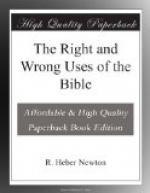Thy word is a lamp unto my
feet,
And a light unto my path.
Such is the holy office of the Bible: such be its blessed service to our souls, and to the souls of our dear children! May we walk in its light through life; that in the valley of the shadow of death that light may still fall upon us.
It is not many months since I was called to the house where, in a ripe and honored age, lay a warden of this church, stricken suddenly by death. On the table in his room, as he had left it open after reading in it that morning, I saw a Bible.
I can ask for my funeral no better symbol of the aim and effort of my poor erring life, if so be it shame me not too much, than that which told the story of an humble servant of the Lord. Upon his coffin, with the book-mark between the pages where he last had read, was—his Bible!
* * * * *
Blessed Lord, who hast caused all holy Scriptures to be written for our learning; grant that we may in such wise hear them, read, mark, learn, and inwardly digest them, that by patience and comfort of Thy Holy Word, we may embrace and ever hold fast the blessed hope of everlasting life, which Thou has given us in our Saviour, Jesus Christ. Amen.
The End.
Footnotes
[1] The Second Sunday in Advent.
[2] 1 Cor. vii. 10.
[3] 1 Cor. vii. 12.
[4] 1 Cor. vii. 40.
[5] 1 Cor. vii. 25.
[6] Hebrews i. 1.
[7] 2 Peter i. 21.
[8] 1 Peter i. 10, 11.
[9] 2 Timothy iii. 16.
[10] Sacred Books of the East, vol. i. p. xiii.
[11] 2 Maccabees, ii. 13.
[12] “The Jews and the priests have found it good that Simon shall be their leader and high priest forever until there shall arise a trustworthy prophet.”—1 Macc. xiv. 41.
[13] Introduction to the New Testament. Samuel Davidson, I.:279.
[14] Introduction to the New Testament. Samuel Davidson, I.:384.
[15] The contrast between the fifteenth and sixteenth century Confessions of Faith reveals this process, and explains the prevalent Protestant theory.
[16] About 600 A.D.
[17] 2 Maccabees ii. 13.
[18] The Dial: October, 1840.
[19] Ewald: History of Israel, i. 4.
[20] Esther is the most notable apparent exception, but this it only apparent.
[21] In speaking of the book of Esther, Dean Stanley observes that “it never names the name of God from first to last,” and remarks “It is necessary for us that in the rest of the sacred volume the name of God should constantly be brought before us, to show that He is all in all to our moral perfection. But it is expedient for us no less that there should be one book which omits it altogether, to prevent us from attaching to the mere name a reverence which




